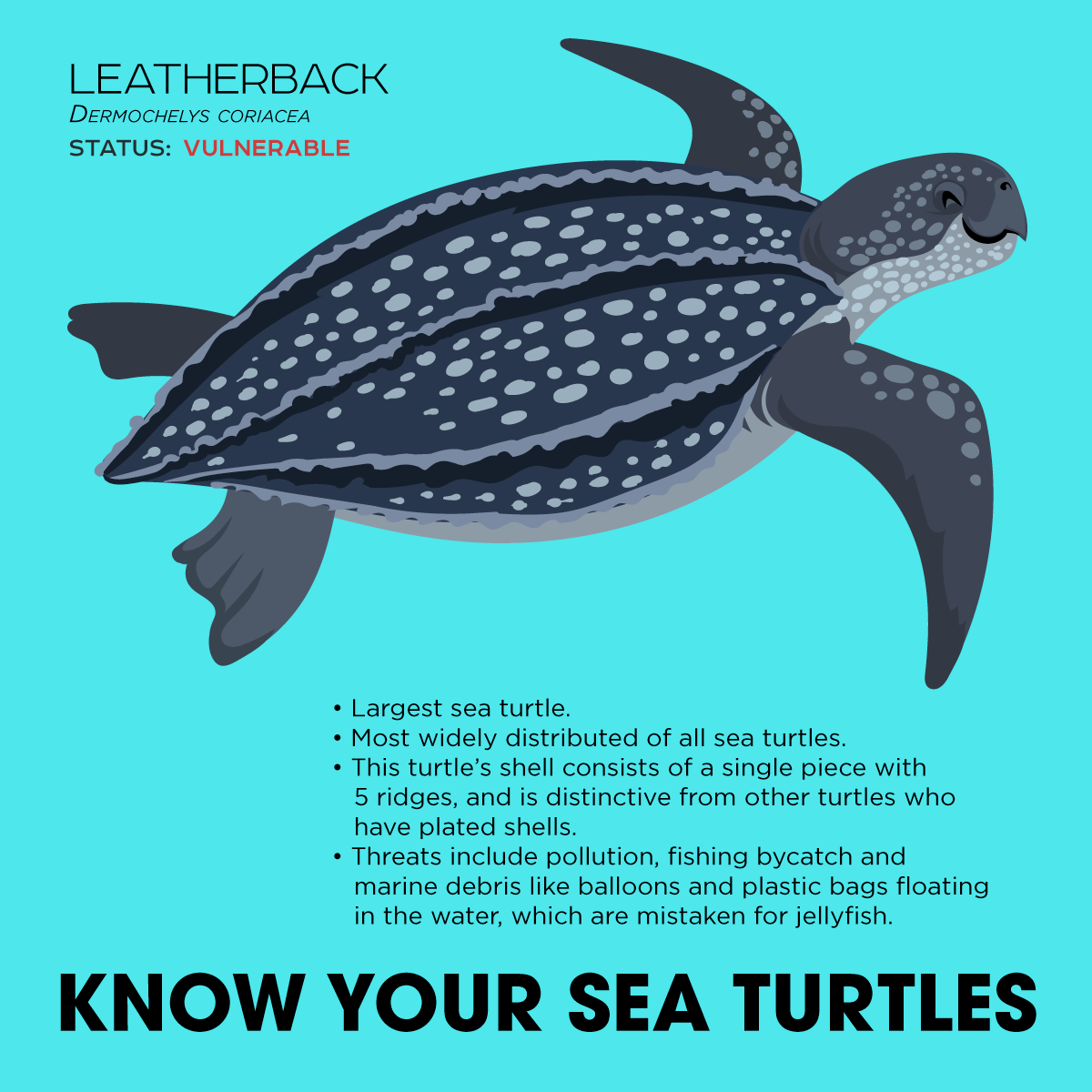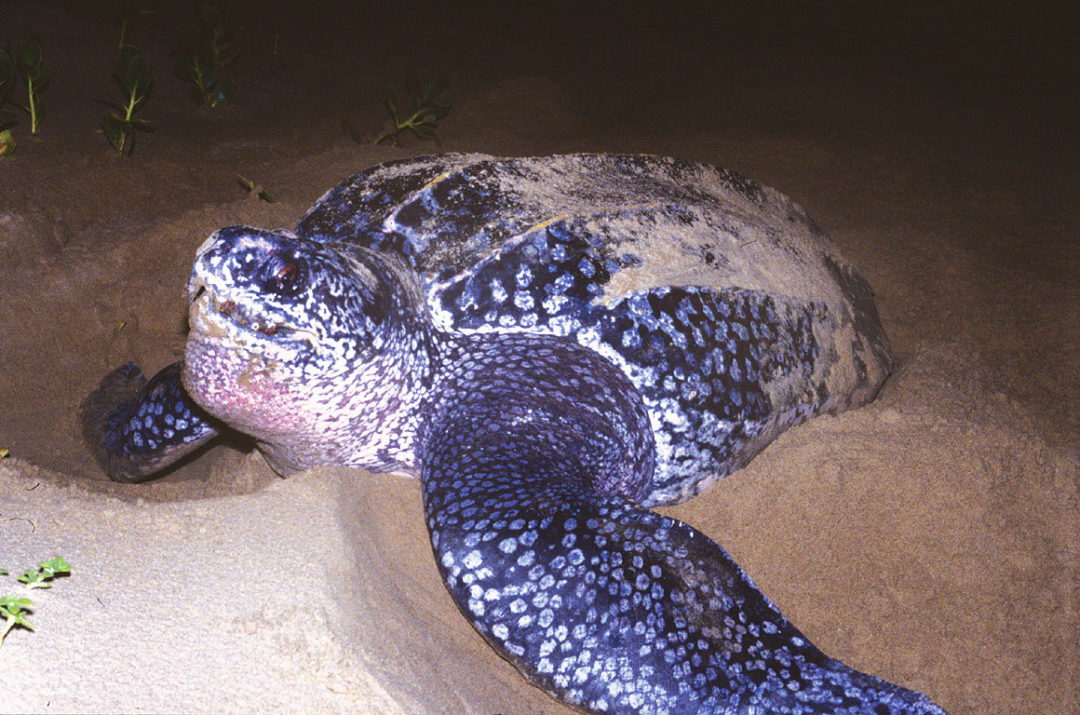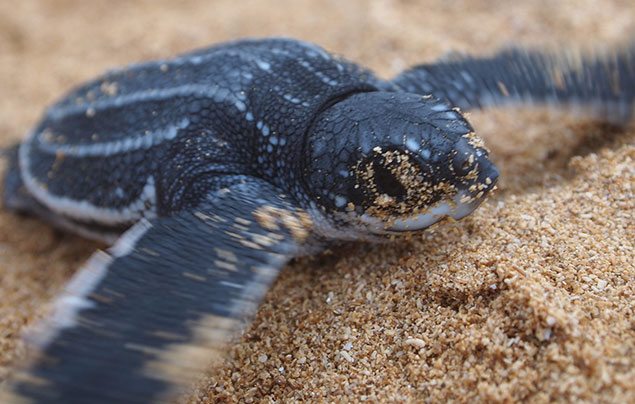
Illustration from: http://www.seaturtleinc.org/education/about-sea-turtles/leatherback/
Turtles and tortoises are some of the most long-lived members of the reptile family. Even small species that are typically kept as pets, like box turtles and terrapins, live between 30 and 40 years if they’re kept healthy. Larger species such as sea turtles are estimated to live about 80 years. The giant tortoise, the largest of all land turtles, typically lives at least a century. Some have even been known to live for more than 200 years! What about the leatherback turtle?
Guyana’s Giant Leatherback Turtle
The giant leatherback turtle can live up to 30 years, some reports claim up to 50 years while some upper estimates exceed 100 years. The leatherback is sometimes called the lute turtle or leathery turtle or simply the luth. It is the largest of all living turtles and is the fourth-heaviest modern reptile behind three crocodilians. It can easily be differentiated from other modern sea turtles by its lack of a bony shell; its carapace is covered by skin and oily flesh. It is the only living species in the genus Dermochelys and family Dermochelyidae.
Did you know?
- Leatherback turtles are named for their shell, which is leather-like rather than hard, like other turtles.
- The leatherbacks have the greatest migratory distribution of any reptile on the planet.
Leatherbacks are the deepest diving turtles; they have been documented for diving deeper than 4,000 feet. It is said that the leatherbacks are the oldest of all sea turtle species, it has been around for more than 150 million years. They survived the extinction of the dinosaurs and thrived until the last several decades when human interactions have taken a major toll.
The leatherbacks are world travelers; they are found in tropical and temperate marine waters all over the world. They have a large pair of front flippers which powers them through the water; their rear flippers help steer them. Their front flippers don’t have claws and are the largest flippers of any sea turtle. Their head is triangular and their body is barrel-shaped, covered by a large, black, speckled shell (or carapace). Unlike all other sea turtles, these giants do not possess a carapace covered with hard scales (scutes). Instead of scutes, it has thick, leathery skin with embedded minuscule osteoderms and seven distinct ridges rise from the carapace, crossing from the cranial to caudal margin of the turtle’s back. Their smooth, leathery skin covers a flexible matrix of bone. The entire turtle’s dorsal surface is colored dark grey to black, with a scattering of white blotches and spots. They do not have teeth but they do have points on the tomium of their upper lip.
Diet of the Giant Leatherback Turtle

Image Source: https://www.mcsuk.org/learn-about-turtles/species/leatherback-turtle
Leatherbacks have downward-pointing spines in their throat, which allows jellyfish to be swallowed, but prevents them from coming back up. Jellyfish make up the biggest portion of their diet, but they also eat seaweed, fish, crustaceans, and other marine invertebrates. Leatherbacks can consume twice their own body weight in prey per day.
Habitat of the Giant Leatherback Turtle
Primarily, the leatherbacks are found in open oceans and their favored breeding beaches are mainland sites facing deep water. The most significant Atlantic nesting sites are in Suriname, Guyana, French Guiana in South America, Antigua and Barbuda, and Trinidad and Tobago in the Caribbean, and Gabon in Central Africa.
Reproduction and Offspring of the Leatherbacks
They mate in the sea and once the males enter the water they never leave it. On the other hand, the females come up to the land to nest. When a male meets a female, he uses head movements; nuzzling, biting, or flipper movements to determine her receptiveness. The females mate every two to three years while the male mates every year; multiple males usually mate with a single female. Leatherbacks reach maturity at approximately 16 years old.

Image Source: https://www.natgeokids.com/za/discover/animals/sea-life/leatherback-turtle-facts/
Offspring: Like most reptiles, temperature determines the gender of the offspring—if it’s warm inside the nest, females will be born. Likewise, if temperatures are cooler, males develop. Once the eggs hatch, they’re on their own—the baby sea turtles must make it into the water and learn to fend for themselves without any care from their parents.
Scientific Classification of the Leatherback
Leatherback Turtle – Dermochelys coriacea [Scientific name]
- Kingdom: Animalia
- Phylum: Chordata
- Class: Reptilia
- Order: Testudines
- Suborder: Cryptodira
- Family: Dermochelyidae
- Genus: Dermochelys Blainville, 1816
- Species: D. coriacea
Tip:
Leatherbacks are the largest of the seven living sea turtle species, growing to more than 6.5 in length and weighing up to 2,000 pounds (900 kilograms).
Where to find Guyana’s Giant Leatherback turtle?
There is a beach in Guyana called Shell Beach; the giant leatherback comes to this beach every year to nest. Nesting season for these reptiles begins in March and continues until August. These reptiles are a major attraction to Guyana; they are huge, strong and unique. Guyana is privileged to have the leatherback turtle – the largest of all living turtles.
Protection Efforts in Guyana
Turtles used to be slaughtered for their meat and eggs. The area is now part of a non-governmental conservation program called the Guyana Marine Turtle Conservation Society (GMTCS), founded by Dr. Peter Pritchard and Romeo De Freitas. Shell Beach is not formally protected, although direct and indirect conservation activities to protect the nesting sea turtles started in the 1960s, when Dr. Peter Pritchard first began annual research visits. Due to his efforts to conserve the turtles in the region, Dr. Peter Pritchard was dubbed “Hero of the Planet” by Time.
The conservation programme allows for the protection of the turtles and their eggs until they are hatched and are assisted to the ocean. The three main donor agencies which have been faithfully supporting the project from the beginning are Chelonian Research Institute, Simpson Oil Limited Inc. (earlier Shell Antilles-Guyana) and the World Wildlife Funds.
According to the Guyana Marine Turtle Conservation Society, the turtle population over the years had developed and data analysis of nesting females had also expanded. But it is still a challenge to reduce the instances of human activities such as fishing in the nearby coastal waters and in front of nesting beaches, which contribute to the loss of many adult turtles that had been caught accidentally and drowned in nets. see more about Shell Beach here: https://www.thingsguyana.com/ever-wondered-why-it-is-called-shell-beach/
Article References:
- https://en.wikipedia.org/wiki/Leatherback_sea_turtle
- https://www.stabroeknews.com/2016/news/guyana/04/30/shell-beach-rangers-rescue-leatherbacks-eggs/
- https://www.nwf.org/Educational-Resources/Wildlife-Guide/Reptiles/Sea-Turtles/Leatherback-Sea-Turtle
- https://www.natgeokids.com/za/discover/animals/sea-life/leatherback-turtle-facts/
- https://www.seeturtles.org/leatherback-turtles/
- https://www.thoughtco.com/leatherback-sea-turtle-facts-2291982
Discover more from Things Guyana
Subscribe to get the latest posts sent to your email.






